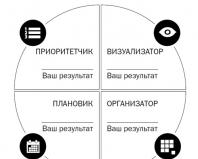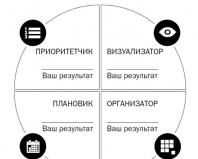Presentation of characteristics of various insects that transmit disease. Lesson: "Insects that transmit human pathogens and parasites of farm animals." Arthropods are carriers of diseases
Slide 3
Housefly
A person can become infected from a seemingly harmless housefly. In fact, flies are very dangerous; they are carriers of cholera, typhoid fever, and dysentery.
Slide 4
Cockroaches
Cockroaches, like flies, feed on waste and carry bacteria and microorganisms on their legs, resulting in infection of humans, most often children. Cockroaches can also cause severe allergies in children.
Slide 5
Malaria mosquito
One of the most dangerous types of insects is considered to be mosquitoes, which transmit infection by biting and sucking blood. These insects are carriers of human pathogens: malaria, dengue fever, yellow fever, which kill thousands of people every year.
Slide 6
Tsetse fly
The tsetse fly carries sleeping sickness, which causes blindness. A huge number of people in Africa are going blind from this disease and it is almost impossible to stop this process. Stopping such mass diseases will require hundreds of thousands, millions of dollars, which Africa, as an underdeveloped state, cannot afford to spend on purchasing medicines and protective equipment.
Slide 7
Blood-sucking insects: fleas and lice
Lice are carriers of typhus and relapsing fever, and fleas are carriers of plague.
Adult fleas feed exclusively on blood, sucking up to 20 times their own weight in blood every day.
Flea bites are painful, causing severe itching and inflammation of the skin.
Slide 8
Horsefly
Horseflies are carriers of tularemia and anthrax
Slide 9
The most dangerous insects that carry pathogens live and breed in regions with high average temperatures: tropical and subtropical climates. Due to the onset of global warming, these regions are moving north, insects are beginning to capture new territories, adapt and reproduce in new areas.
Also, due to warming, mosquitoes begin to multiply exponentially, as water bodies dry up under the influence of high temperatures and turn into puddles or swamps, the most comfortable places for mosquitoes to live, which are carriers of diseases dangerous to humans.
View all slides
Alvana
Presentation for parents “Insects are carriers of dangerous infections: be careful!”
Infectious diseases, transmitted from the carrier organism to the recipient organism through an intermediate carrier are called transmission (from lat. "transmission" – broadcast). In this way they can transmitted by protozoans, viral and bacterial infections, A vectors may include mammals, birds, fish and other fauna.
It is known that carriers of some, often dangerous infections, are different insects, many of which live in human habitation areas.
Our planet inhabits a huge number of such insects. Some of them are beneficial, and some are harmful. However, there are those that carry a deadly danger. It is important to know as much as possible about these creatures and be able to protect yourself from them.
The most common are: mosquitoes, bedbugs. ticks, lice, fleas and flies.
Let's take a closer look at each of these types.
Publications on the topic:
KVN according to traffic rules “The smallest road sign, it’s there for a reason! Be careful people, respect every sign!” Educator: - Hello, our dear guests! We are glad to see you at our holiday, which we dedicated to road signs and rules.
Lapbook “Be careful on the road.” I have been using a lapbook methodological guide in my work for a long time. We made it together with the children. Intended.
Presentation "Insects" Summer! This is a wonderful time of year when you can admire the beauty of nature at every step. You just need to not miss out on amazing moments.
Presentation “Insects” for preschool children Most modern children rarely communicate with nature. Therefore, my presentation is aimed at ensuring that our children learn to love and take care.
Presentation “Insects” for teachers of audiology groups The presentation is intended for educators, teachers and teachers of audiology groups. Gives an idea of the diversity of the insect world.
Presentation "Insects" In this presentation you will find a lot of interesting things for yourself and your kids. I tried to decorate useful information with bright pictures.
Presentation “Insects, amphibians, reptiles” Insects are among the most numerous and ubiquitous living creatures on Earth. They constitute a vast group of animals with millions of varieties.
A project to develop parents’ interest in children’s physical activity “Be healthy!” Problem: parents' disinterest in organizing their children's physical activity. Justification of the problem: - lack of awareness of parents.
Sections: Biology
Equipment: collections of flies, microspecimen “Mosquito mouthparts”, microscopes, presentation on this topic with slides, projector, screen, computer.
During the classes
Test work on insect orders:
“I would love summer if... there weren’t mosquitoes and flies...” A.S. Pushkin
Student presentations with prepared messages.
Insects are carriers of human pathogens.
Housefly. The housefly belongs to the order Diptera. An adult fly eats the same food as a human. Every 2-4 days, a female housefly lays 150 eggs. After 13 days, the egg hatches into a larva. Fly larvae develop in various kinds of rotting waste. Fly larvae are white, headless and legless. After 10 days, the larva turns into a pupa. After 3 days, an adult fly emerges from the pupa. On itself and in itself (in the intestines) the fly carries up to 30 million bacteria, including the causative agents of dysentery and typhoid fever.
Demonstrates the collection “Order Diptera. Flies"
Medical worker: Typhoid fever is an infectious disease caused by the typhoid bacillus.
Symptoms: increased body temperature, weakness, malaise, headache, enlarged liver and spleen, sometimes lethargy, hallucinations, delirium, loss of consciousness. There may be complications - intestinal bleeding, intestinal perforation. In order not to become infected with this disease, it is necessary to fight flies: use nets on windows and vents, kill flies, and use repellents. Repellents are means that repel insects.
Invite students to examine the microslide “Mosquito Oral Apparatus.” Questions for the class after studying the structure of the proboscis under a microscope: “What does the proboscis of a mosquito remind you of? Why is this organ called piercing-sucking?” Explain that the mosquito’s proboscis is an adaptation to blood sucking.
Horseflies. Horseflies are representatives of the order Diptera. Body length – 2 cm. Horse flies have bright green eyes. Female horseflies painfully bite warm-blooded animals: cows, horses, moose, deer, birds, humans. Males feed on flower nectar. Females need blood for egg development. Horsefly bites are a nuisance to agricultural insects, and their bites can reduce milk yield in cows.
Consolidation of knowledge.
1. Find a match:
2. Find a match:
3. Find a match.
1 slide


3 slide
A person can become infected from a seemingly harmless housefly. In fact, flies are very dangerous; they are carriers of cholera, typhoid fever, and dysentery.

4 slide
Cockroaches, like flies, feed on waste and carry bacteria and microorganisms on their legs, resulting in infection of humans, most often children. Cockroaches can also cause severe allergies in children.

5 slide
One of the most dangerous types of insects is considered to be mosquitoes, which transmit infection by biting and sucking blood. These insects are carriers of human pathogens: malaria, dengue fever, yellow fever, which kill thousands of people every year.

6 slide
The tsetse fly carries sleeping sickness, which causes blindness. A huge number of people in Africa are going blind from this disease and it is almost impossible to stop this process. Stopping such mass diseases will require hundreds of thousands, millions of dollars, which Africa, as an underdeveloped state, cannot afford to spend on purchasing medicines and protective equipment.

7 slide
Lice are carriers of typhus and relapsing fever, and fleas are carriers of plague. Adult fleas feed exclusively on blood, sucking up to 20 times their own weight in blood every day. Flea bites are painful, causing severe itching and inflammation of the skin.

8 slide

Slide 9
The most dangerous insects that carry pathogens live and breed in regions with high average temperatures: tropical and subtropical climates. Due to the onset of global warming, these regions are moving north, insects are beginning to capture new territories, adapt and reproduce in new areas. Also, due to warming, mosquitoes begin to multiply exponentially, as water bodies dry up under the influence of high temperatures and turn into puddles or swamps, the most comfortable places for mosquitoes to live, which are carriers of diseases dangerous to humans.

Insects are pests of cultivated plants and carriers of human diseases.
Ushkareva V.Ya.
biology teacher MKOUBSOSH No. 2p. Brady
You will learn :: You will learn ::- What is the negative impact of insects on cultivated plants, animals and human health? Remember:
- What field and fruit and berry crops are damaged by insects?
- What diseases are carried by insects?
Crop pests
Locust invasion
Aphids suck
plant juices
Turtle damage
cereals
Beet larvae
weevils feed
beet roots.
Apple flower beetle larvae feed on the ovaries of apple trees.
Larvae and adults
the Colorado potato beetle is destroyed
potato leaves
Cabbage white larvae feed
cabbage leaves.
Apple codling moth larvae
develop in apples
Moth larvae live in flour
Clothes moth larvae
spoil wool products
Horseflies feed on animal blood
Horseflies defeated
Gadfly larvae develop
under the skin of mammals
Mosquitoes: malaria,
mosquito encephalitis.
Tsetse fly: sleeping sickness
Autumn burner:
anthrax
Common fly: dysentery, typhoid fever,
carries roundworm eggs and various microbes.
Black cockroaches and black cockroaches contaminate and spoil food with their excrement.
They carry pathogens and worm eggs. Cockroach secretions often cause allergies in people.
Lice: carry pathogens
typhus and relapsing typhus.
Bed bugs feed
blood
Fleas eat
blood.
These pathogens are transmitted to humans
diseases such as plague, tularemia, typhus.
Physical
Chemical
Agrotechnical
Biological
- Sowing and planting of plants is carried out in such a way that they have time to get stronger by the time the pests appear.
- Destroy weeds. The fields are carefully cleaned
Methods for controlling harmful insects
Anthills of red ants
Artificial nesting boxes for
small insectivorous birds
Equestrians are bred in laboratories.
With cabbage whites
struggling, releasing
Trichogramma parasite, the female of which lays eggs in the eggs of the cabbage white.
Ladybug is a predator.
Let's sum it up
- Among the insects there are pests of cultivated plants and food supplies, and many carriers of dangerous diseases of humans and domestic animals.
- People control pests that cause damage using physical, chemical, agronomic and biological methods.
- Agricultural pests;
- Pest Control Methods (physical, chemical, agrotechnical, biological).
- Describe the activities of insects -
pests of agricultural plants.
2. Name the most common insects that carry
pathogens of human diseases.
3. Assess the effectiveness of control methods
with harmful insects.
4. Using information resources, determine the identity of the insects,
mentioned in the text of the paragraph, to
systematic groups.
provide this information




